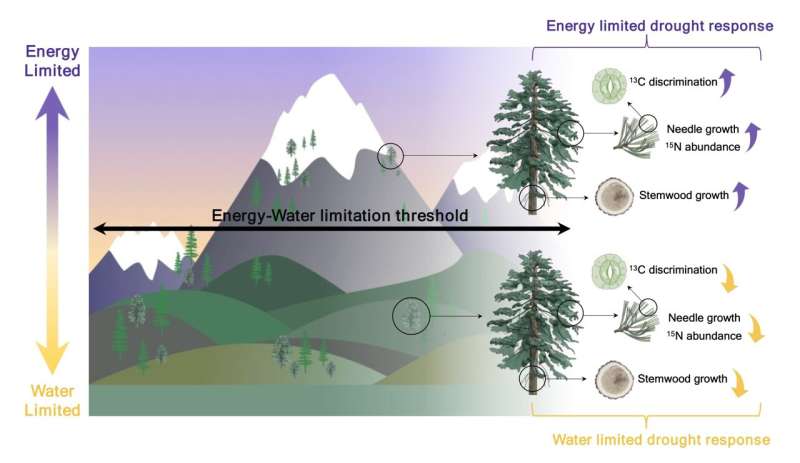This article has been reviewed according to Science X's editorial process and policies. Editors have highlighted the following attributes while ensuring the content's credibility:
fact-checked
peer-reviewed publication
trusted source
proofread
How a drought affects trees depends on what's been holding them back

Droughts can be good for trees; certain trees, that is.
Contrary to expectation, sometimes a record-breaking drought can increase tree growth. Why and where this happens is the subject of a new paper in Global Change Biology.
A team of scientists led by Joan Dudney at UC Santa Barbara examined the drought response of endangered whitebark pine over the past century. They found that in cold, harsh environments—often at high altitudes and latitudes—drought can actually benefit the trees by extending the growing season. This research provides insights into where the threats from extreme drought will be greatest, and how different species and ecosystems will respond to climate change.
Many factors can constrain tree growth, including temperature, sunlight and the availability of water and nutrients. The threshold between energy-limited and water-limited systems turns out to be particularly significant. Trees that try to grow in excessively cold temperatures—often energy-limited systems—can freeze to death. On the other hand, too little water can also kill a tree, particularly in water-limited systems. Over time, many tree species have adapted to these extreme conditions, and their responses are broadly similar. They often reduce growth-related activities, including photosynthesis and nutrient uptake, to protect themselves until the weather improves.
"Interestingly, the transition from energy- to water-limited growth can produce highly unexpected responses," explained Dudney, an assistant professor in the Bren School of Environmental Science & Management and the Environmental Studies Program. "In cold, energy-limited environments, extreme drought can actually increase growth and productivity, even in California."
Dudney and her colleagues extracted 800 tree cores from whitebark pine across the Sierra Nevada, comparing the tree rings to historical records of climate conditions. This climate data spanned 1900 to 2018, and included three extreme droughts: 1959–61, 1976–77, and 2012–15. They recorded where tree growth and temperature showed a positive relationship, and where the relationship was negative.
The authors found a pronounced shift in growth during times of drought when the average maximum temperature was roughly 8.4° Celsius (47.1° Fahrenheit) between October and May. Above this threshold, extreme drought reduced growth and photosynthesis. Below this temperature, trees grew more in response to drought.

"It's basically 'How long is the growing season?'" Dudney said. Colder winters and higher snowpack often lead to shorter growing seasons that constrain tree growth. Even during an extreme drought, many of the trees growing in these extreme environments did not experience high water stress. This surprised the team of scientists, many of whom had observed and measured the unprecedented tree mortality that occurred at slightly lower elevations in the Sierra Nevada.
Dudney was curious about whether drought impacts growth in just the main trunk, or the whole tree. Without more data, the trends they saw could be a result of disparate processes all responding to the drought differently, she explained. Fortunately, whitebark pine retains its needles for roughly eight years. This provided additional data that could address this question.
The researchers shifted their attention from dendrology to chemistry. Atoms of the same element can have different weights, or isotopes, thanks to the number of neutrons they contain. Several aspects of a plant's metabolism can influence the relative abundance of (heavy) carbon-13 and (light) carbon-12 in tissues such as their leaves and needles. These changes provide a rough guide to the amount of water stress a tree might have experienced during drought. This was a boon for the researchers, because isotopic data from the pine needles spanned drought and non-drought years.
Analyzing needle growth, carbon and nitrogen isotopes revealed that the whole tree was affected by the threshold between water-limited and energy-limited systems. Trunk growth, needle growth, photosynthesis and nutrient cycling responded in opposite directions to drought above and below the threshold between energy- and water-limited systems.
The future of whitebark pine is highly uncertain. The species—recently listed as threatened under the Endangered Species Act—faces many threats, including disease, pine beetle infestation and impacts from altered fire regimes. It's clear from this research that drought and warming will likely exacerbate these threats in water-limited regions, but warming may be beneficial for growth in energy-limited environments.
"This research can help develop more targeted conservation strategies," said Dudney, "to help restore this historically widespread tree species." Indeed, the pine's range encompasses a diverse region, stretching from California to British Columbia, and east to Wyoming.
The findings also have implications more broadly. Approximately 21% of forests are considered energy-limited, and an even higher percentage can be classified as water-limited. So transitions between these two climatic regimes likely occur around the globe. What's more, the transition seems to have an effect on nitrogen cycling. Trees in water-limited environments appeared to rely less on symbiotic fungi for nitrogen, which is critical for tree growth in harsh, energy-limited environments.
"Droughts are leading to widespread tree mortality across the globe," Dudney said, "which can accelerate global warming."
Deciphering the many ways trees respond to drought will help us better predict where ecosystems are vulnerable to climate change and how to develop more targeted strategies to protect our forests.
More information: Joan Dudney et al, The energy–water limitation threshold explains divergent drought responses in tree growth, needle length, and stable isotope ratios, Global Change Biology (2023). DOI: 10.1111/gcb.16740
Journal information: Global Change Biology
Provided by University of California - Santa Barbara




















